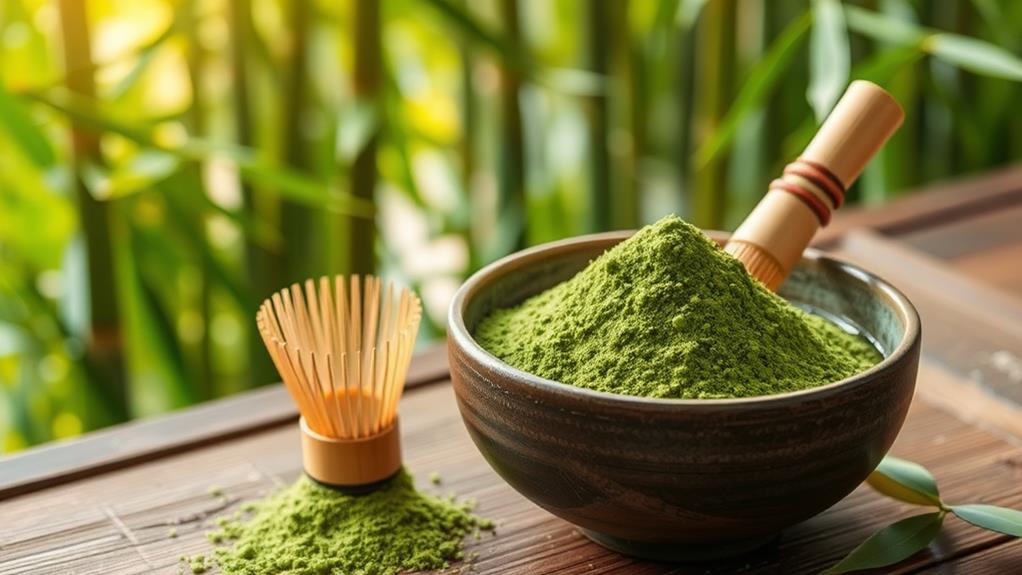If you're new to matcha, you're in for a treat! This vibrant green powder comes from finely ground tea leaves and offers a unique flavor, rich history, and tons of health benefits. Matcha boosts your energy smoothly, supports heart health, and is packed with antioxidants. When choosing matcha, look for a bright green color, indicating good quality. Preparing it is easy—just whisk some powder with hot water for a frothy delight. You can also enjoy matcha in smoothies, baked goods, or sprinkled on yogurt. There's so much more fun to explore in the matcha world!
What Is Matcha?
Matcha is a finely ground powder made from specially grown green tea leaves. It's not just your average tea; it has a rich matcha history that dates back to ancient China, where it first gained popularity in the Tang Dynasty.
You might find it fascinating that monks brought it to Japan, where it evolved into a ceremonial tradition. This journey has shaped the innovative ways we enjoy matcha today.
When you explore matcha varieties, you'll discover a spectrum ranging from ceremonial grade to culinary grade. Ceremonial grade is the highest quality, perfect for traditional tea ceremonies, while culinary grade is great for baking or mixing into beverages.
Each variety has its unique flavor profile and texture, allowing you to experiment and find your favorite.
Whether you're sipping a frothy matcha latte or incorporating it into a dessert, you'll appreciate how deeply rooted matcha is in culture and creativity.
Health Benefits of Matcha
Numerous health benefits come from incorporating matcha into your diet. This vibrant green tea isn't just a trend; it's packed with powerful nutrients that can enhance your well-being. One of the standout features of matcha is its high antioxidant properties, which help combat free radicals in your body. This means you can enjoy healthier skin and potentially lower your risk of chronic diseases.
Additionally, matcha's caffeine content provides a smooth energy boost without the jitters commonly associated with coffee. You'll feel more focused and alert, making it a perfect drink for those busy days.
Here's a quick overview of matcha's health benefits:
| Benefit | Description |
|---|---|
| Antioxidant Properties | Fights free radicals and reduces inflammation |
| Energy Boost | Provides a steady caffeine lift for clarity |
| Metabolism Support | Can help with weight management and metabolism |
| Heart Health | May promote cardiovascular health |
| Detoxification | Supports liver function and helps cleanse the body |
Incorporating matcha into your routine can be a simple yet innovative way to boost your health. So, why not give it a try? Your body will thank you!
How to Choose Quality Matcha
When it comes to reaping the health benefits of matcha, choosing the right quality is key. You'll want to look for vibrant green powder, as this indicates freshness and quality. The best matcha often comes from Japan, where it's grown in shaded areas, enhancing its rich taste profiles.
Additionally, exploring the cultural significance of tea can deepen your appreciation for matcha and its origins.
Next, consider the different ceremony styles. Ceremonial grade matcha is perfect for traditional tea ceremonies and offers a smooth, pleasant flavor. On the other hand, culinary grade matcha is ideal for baking or mixing into smoothies.
If you're seeking a delightful experience, stick with ceremonial grade for that pure, authentic matcha taste.
Don't forget to check the packaging! Quality matcha should be sealed in an opaque container to protect it from light and moisture.
And if you can, read reviews or ask for recommendations. Remember, the right matcha can elevate your daily routine, making it both enjoyable and beneficial.
With these tips in mind, you're ready to explore the vibrant world of matcha and discover which quality suits your taste and lifestyle best! Happy sipping!
Preparing Matcha at Home
To prepare matcha at home, you'll want to gather a few essential tools for the best experience. Start with a matcha bowl, a fine mesh sieve, and, of course, a bamboo whisk, known as a chasen. These matcha tools are crucial for achieving that frothy, vibrant cup you're aiming for.
Begin by sifting about one to two teaspoons of matcha powder into your bowl. This step helps break up any clumps, ensuring a smooth drink. Next, add about 2 ounces of hot water, ideally around 175°F.
Now comes the fun part: whisking! Using your chasen, employ whisk techniques that create a gentle "M" or "W" motion. This method not only blends the matcha but also aerates it, creating a lovely froth on top.
Don't rush this step; take your time to enjoy the process! Once you've achieved a creamy texture, you can adjust the water to your preferred strength.
Sip your matcha with pride, knowing you've mastered the art of preparing it at home. With practice, you'll discover the joy of crafting the perfect cup tailored to your taste!
Creative Ways to Enjoy Matcha
Once you've mastered the art of preparing matcha at home, it's time to explore creative ways to enjoy this versatile ingredient. Why not start with matcha smoothies? Blend a teaspoon of matcha with your favorite fruits, a splash of almond milk, and ice for a refreshing twist. It's a delicious way to kickstart your morning or recharge in the afternoon!
If you've got a sweet tooth, matcha desserts are calling your name. Try baking matcha cookies or brownies for a unique treat that'll impress your friends. The vibrant green color and earthy flavor will have everyone asking for the recipe.
You can even whip up some matcha ice cream—just mix matcha with coconut milk, sweetener, and freeze.
Feeling adventurous? Use matcha as a topping for yogurt or oatmeal. Just sprinkle a little on top for added flavor and a health boost.
The options are endless! So grab your matcha and let your creativity flow. With these ideas, you'll not only enjoy matcha's health benefits but also elevate your culinary skills. Get ready to impress your taste buds!
FAQ
Can Matcha Be Consumed by People With Caffeine Sensitivity?
If you're sensitive to caffeine, matcha might not be for you due to its caffeine effects. Consider matcha alternatives like herbal teas or grain-based drinks that provide energy without the jitters. Explore innovative options!
Is Matcha Safe for Children?
Absolutely, matcha can be safe for kids! Its health benefits are amazing, plus you can prepare it in fun ways. Just remember to moderate their intake, balancing excitement with caution for the little ones.
How Does Matcha Compare to Green Tea in Taste?
When you compare matcha to green tea, you'll notice distinct flavor profiles. Matcha has a rich, creamy taste with umami notes, while green tea offers lighter, more delicate taste nuances. Each brings a unique experience to your palate.
Can I Use Matcha in Baking?
Absolutely, you can use matcha in baking! Explore matcha recipes like cookies or cakes. Just remember to adjust your sugar levels, as matcha's earthy flavor can balance sweetness. Enjoy experimenting with innovative baking tips!
What Is the Origin of Matcha?
Like a secret garden, matcha's history unfolds in ancient China, where Zen monks cultivated it for meditation. Its journey to Japan transformed matcha cultivation, turning it into a symbol of innovation and mindfulness in tea culture.
Final Thoughts
So there you have it! Matcha isn't just a fancy green drink for hipsters; it's a powerhouse of health benefits and creativity. Whether you're brewing it like a pro or tossing it into your smoothies, you're part of a centuries-old tradition. Just remember, not all matcha is created equal—cheap stuff might taste like lawn clippings. So, go ahead, embrace your inner tea snob, and enjoy the vibrant world of matcha without the pretentiousness!




Pingback: Water With... - TeaKram
Pingback: Americans Fascination With the Japanese Tea Ceremony - TeaKram